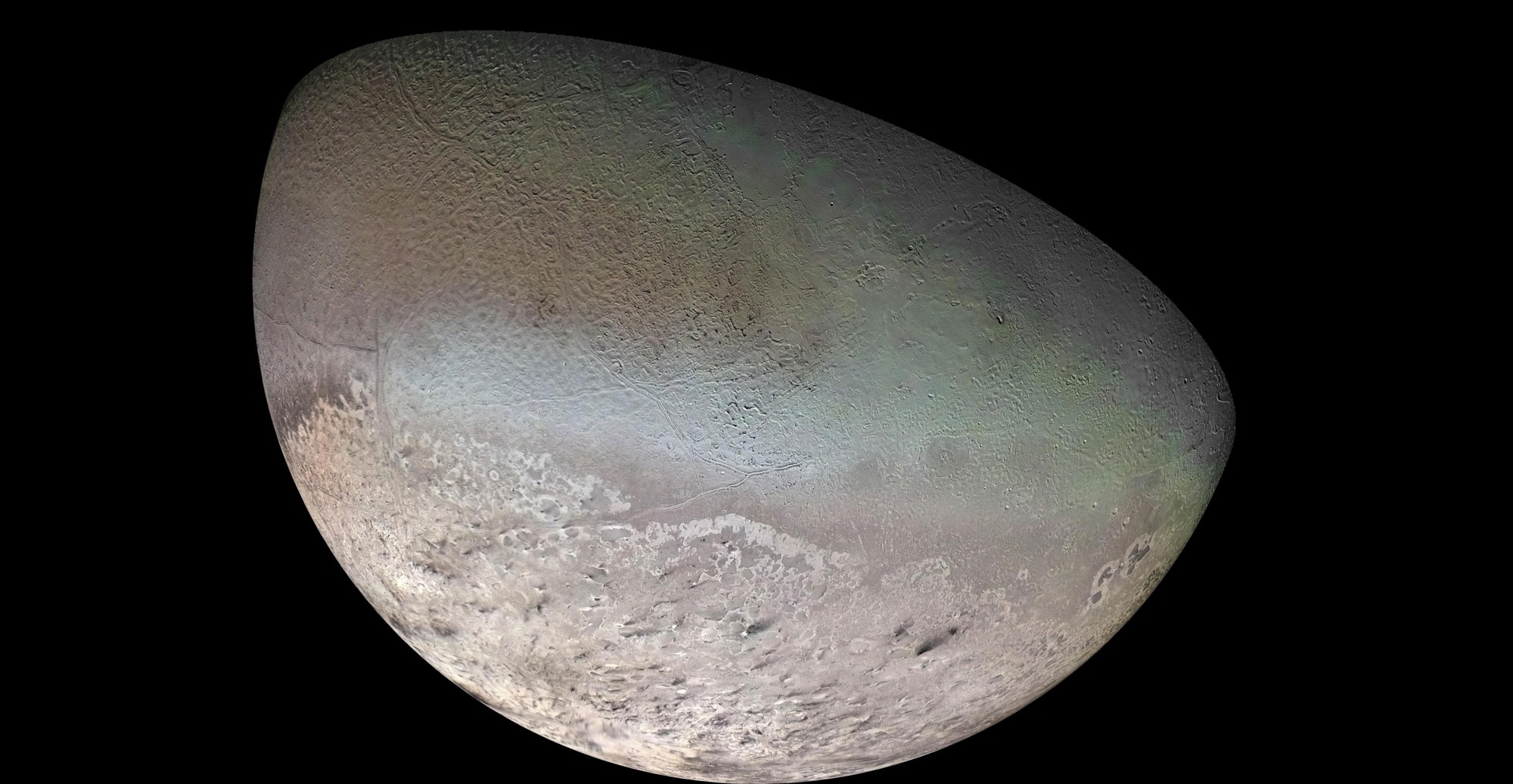A flash from Triton

Astronomers ask odd questions.
Like, how can you learn more about the extremely tenuous atmosphere around an icy moon orbiting a planet 4.5 billion kilometers away?
The fun thing is, we can answer it: Wait until the moon passes directly in front of star, and watch the atmosphere flash at you*.
I'm not even kidding.
Triton is the largest moon of Neptune, the farthest planet from the Sun. It's a big moon, 2,700 kilometers across, and because it's so cold out there — about 40 K, which is -230°C or -390°F — its surface is covered in ices like frozen nitrogen and methane.
However, it just barely gets warm enough that during local summer the nitrogen thaws, and turns into a gas. A ridiculously thin one, covering the moon in an atmosphere only about 0.000015 as dense as Earth's. That's practically a vacuum. On our planet you'd have to go up practically into space to get to where our air is that attenuated.
But it's there. In fact, there's even wind, such as it is; when Voyager 2 passed Neptune and Triton in 1989 it saw aligned black streaks on the moon's surface, evidence of vents of nitrogen and carbon-rich dust erupting out of the surface and getting blown downwind.
Voyager 2 flew past at high speed, and couldn't study Triton's surprising atmosphere very much. But there's another way to do that, and it doesn't even involve leaving Earth.
Every now and again, an object in the solar system will pass directly in front of a star as seen from Earth. We call these events occultations, and they're relatively rare. For small and/or distant bodies they're even more rare, so Triton doesn't do this terribly often. But astronomers predicted that on October 5, 2017, the frigid moon would occult the star UCAC4 410-143659 (or, if you prefer, it's also called 2MASS 22541840-0800082 and/or USNO B 0819-0776968). The star isn't terribly bright, but it's brighter than Triton at nearly all wavelengths, making this event easier to see; if you observe it you'd see the star suddenly blink out, and only the light from Triton would remain. A little less than three minutes later, the star would pop out from the other side of Triton, appearing much as it did before.
The event was visible across Europe and the United States, and nearly 80 different observatories were pointed Neptuneward on that evening. And they caught it!
But they also caught something more. Watch this time-lapse animation made from real observations of the event:
Neptune is the bright blob, and Triton + the star just to its upper left. The star suddenly gets fainter when Triton blocks it, then reappears moments later (in the animation; several minutes later in real time).
But… did you see that bright flash of light right in the middle of the observation? The real-time plot helps; rewatch it if you need to.
That event is called a central flash, and it's due to the starlight being bent by Triton's thin atmosphere! Air can act like a lens, bending the path the light takes. In this case, when the star was directly behind Triton (that is, the Earth, Triton, and the star made an almost exact straight line) the air all around the limb of the moon bends the light toward us, and we see a flash of brightness from it. This happened with Saturn's moon Titan in late 2001, and I wrote an article about that describing how it works. The European Space Agency (ESA) also put together an explainer video:
Astronomers are still analyzing the data, but expect to learn a something about Triton's thin nitrogen atmosphere from the event. The total brightness of the flash and how it rises and fades depends on the vertical structure and layering of the gas, so they can use this occultation to probe the atmosphere.
That's very cool. But it gets cooler.
From Earth, Triton's disk is incredibly small, only about 0.1 arcseconds across. For comparison, our own Moon in the sky is about 18,000 times bigger! The star is so far away it's essentially a point source, a dot. The alignment, therefore, had to be extremely precise to get this right. Like a solar eclipse, you have to be in the right place at the right time to see it; it you are too far north or south, the moon would miss the star.
Making this harder is that extremely precise measurements of a star's position are hard to get, so using older positional data for the star meant the path of the occultation's visibility wasn't as accurate as it could be. So astronomers turned to an incredibly precise machine: Gaia.
This is an ESA mission that is mapping the positions of a billion stars in the sky. Yes, a billion. The Gaia team had already released some data, but the star in question wasn't due to have its info released until after the occultation! So astronomers made a special plea to the team to help them, and the Gaia folks jumped in, measuring the star's position in the sky (as well as a bunch of other stars near it) and giving it to the people observing the occultation.
Not only that, they had to compensate for the star's motion! All stars in our galaxy orbit the galactic center, and slowly move across the sky. We call this proper motion, and because stars are so far away the motion is small, but this event was so strict that the star's velocity made a difference. All together, the star's position using Gaia was found to be 0.0142 arcseconds different from the old position, moving the path of visibility about 300 kilometers south.
And it worked! They nailed it. In the diagram above, the pink line was the predicted center of the path using the Gaia data, and the red line is the path determined after the fact using the occultation data. The Gaia data were off by a mere 0.002 arcseconds, an incredible achievement.
I know that part of it may not sound as sexy as the observations themselves, but the Gaia data allowed a far more precise measurement of the event, which is critical to the science itself. Knowing whether the star passed exactly through Triton's center or instead made a shallow chord across the disk is essential for understanding the atmospheric structure, and the new data allows all the observations to be combined in way to greatly enhance what was learned.
And the precision! I'm still stunned by that. Take a tennis ball, which is about 6.7 centimeters across. The difference from the predicted and actual position of the star from the Gaia data would be the difference between the left side of that tennis ball and the right… if it were nearly 7,000 kilometers away. That's far wider than the continental US.
I glow with pride hearing things like this. We're really good at astronomy, folks, and we keep getting better. This is amazing stuff, and just barely scratching the surface of what Gaia will do. A revolution in astronomical measurement is coming, and our capabilities will expand tremendously because of it.
P.S. My thanks to the ESA Science Twitter feed for alerting me to this event and for following up with links. Follow them for more cool European spacey stuff!
* You can also send a space probe there, but that can take a long time and costs more than just sitting around waiting, though, to be fair, you learn a lot more.




























